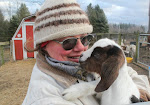She was more than just a cat. She was my friend.
7 years ago
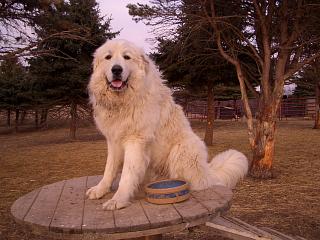 Livestock Guardian Dogs (LGD)--large, aloof, independent breeds such as the Anatolian Shepherd, Kuvaz, Maremma, Burmese Mountain Dog, Komondor and of course, the Great Pyrenees. Unlike herding dogs that depend on livestock's inherent fear of predators, these gentle giants bond with the herd moving effortlessly among the flock.
Livestock Guardian Dogs (LGD)--large, aloof, independent breeds such as the Anatolian Shepherd, Kuvaz, Maremma, Burmese Mountain Dog, Komondor and of course, the Great Pyrenees. Unlike herding dogs that depend on livestock's inherent fear of predators, these gentle giants bond with the herd moving effortlessly among the flock.  I love fall. Maybe I should clarify that statement. I love eating in the fall. The early frosts bring out the sweetness in the chards, kales and brussel sprouts. The vines on the all the potatoes die back signalling their readiness to be dug from the earth softened by autumn rains.
I love fall. Maybe I should clarify that statement. I love eating in the fall. The early frosts bring out the sweetness in the chards, kales and brussel sprouts. The vines on the all the potatoes die back signalling their readiness to be dug from the earth softened by autumn rains.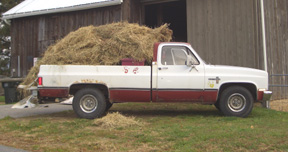

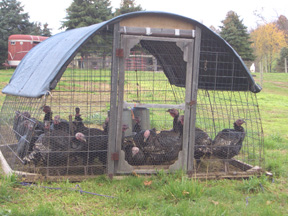
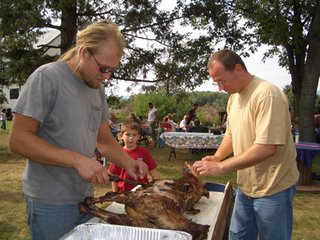 Yes folks, we survived yet another goat roast here on the farm. Over sixty of our family and friends turned out to wind down summer and share the fruits, vegetables, meats and dairy products of our labors. That's Ian Dietrich and Mark Cochran slicing up the roasted goat. There was also BBQ pulled pork and smoked turkey for those not brave enough to partake in the most widely-consumed meat on this planet. Believe it or not, more people eat goat meat than beef, pork, fish, poultry and game.
Yes folks, we survived yet another goat roast here on the farm. Over sixty of our family and friends turned out to wind down summer and share the fruits, vegetables, meats and dairy products of our labors. That's Ian Dietrich and Mark Cochran slicing up the roasted goat. There was also BBQ pulled pork and smoked turkey for those not brave enough to partake in the most widely-consumed meat on this planet. Believe it or not, more people eat goat meat than beef, pork, fish, poultry and game.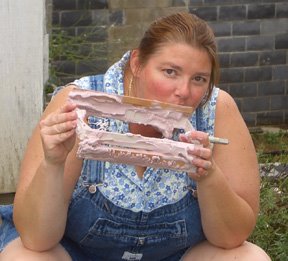 favorite is the home-made ice cream. For the last few years, we always did fresh peach with goat's milk, but sadly this year our wonderful milk goat, Liberty passed away. Breaking from tradition, I procured a few gallons of very fresh, whole Jersey milk. First, I let the luscious thick cream float to the top and then skimmed it for later use. The 'skimmed' milk was mixed with fresh pastured poultry eggs and turned into a custard. When the time was right, I put the custard, fresh cream and a thick syrup made from reduced wild black rasperberry juice and sugar all into a White Mountain Ice Cream Maker and plugged it in. In 20 minutes, we were treated to the most incredible, berry-flavored, silky home made ice cream I've ever done. I made sure everyone got a scoop, but I got my favorite part--to lick off the beaters!
favorite is the home-made ice cream. For the last few years, we always did fresh peach with goat's milk, but sadly this year our wonderful milk goat, Liberty passed away. Breaking from tradition, I procured a few gallons of very fresh, whole Jersey milk. First, I let the luscious thick cream float to the top and then skimmed it for later use. The 'skimmed' milk was mixed with fresh pastured poultry eggs and turned into a custard. When the time was right, I put the custard, fresh cream and a thick syrup made from reduced wild black rasperberry juice and sugar all into a White Mountain Ice Cream Maker and plugged it in. In 20 minutes, we were treated to the most incredible, berry-flavored, silky home made ice cream I've ever done. I made sure everyone got a scoop, but I got my favorite part--to lick off the beaters!
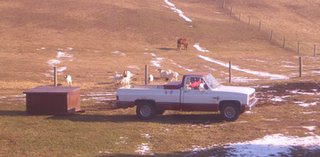 I recently wrote a story for New Farm about turning a junk farm into a functioning sustainable enterprise. When the editor asked me to talk about the financial costs, it got me thinking more about the savings we've done by salvaging, recycling and trading in order to get where we are.
I recently wrote a story for New Farm about turning a junk farm into a functioning sustainable enterprise. When the editor asked me to talk about the financial costs, it got me thinking more about the savings we've done by salvaging, recycling and trading in order to get where we are. So far, all of the kids have been white with brown heads....traditional Boer, regardless of their percentages. But this afternoon Anabelle graced us with our first two paint kids. The doe has a dark brown body with two white legs on the left side. Maybe I'll name her Lefty. The second kid born was a traditional colored buck and a few minutes ago she surprised us with a triplet buck all dark brow with a lightening bolt down his ribs on either side...flashy little devil!
So far, all of the kids have been white with brown heads....traditional Boer, regardless of their percentages. But this afternoon Anabelle graced us with our first two paint kids. The doe has a dark brown body with two white legs on the left side. Maybe I'll name her Lefty. The second kid born was a traditional colored buck and a few minutes ago she surprised us with a triplet buck all dark brow with a lightening bolt down his ribs on either side...flashy little devil! It's hard to believe twenty-oh-six is already here--seems like only yesterday that we were loading up the rig and heading east (in 2000). We've had Jessica back in our lives for just over a year now, too. The goat herd is growing, we've added a calf, (yes, Tibet is still here, but she's camera shy) and we've added another pasture. As a resolution, I'm going to try to keep the farm's blog better updated. There is lots coming up...PA State Farm Show, Pennsylvania Association for Sustainable Agriculture's annual Farming for the Future Conference, kidding season, new laying hens and a fresh batch of turkeys. Stay tuned.
It's hard to believe twenty-oh-six is already here--seems like only yesterday that we were loading up the rig and heading east (in 2000). We've had Jessica back in our lives for just over a year now, too. The goat herd is growing, we've added a calf, (yes, Tibet is still here, but she's camera shy) and we've added another pasture. As a resolution, I'm going to try to keep the farm's blog better updated. There is lots coming up...PA State Farm Show, Pennsylvania Association for Sustainable Agriculture's annual Farming for the Future Conference, kidding season, new laying hens and a fresh batch of turkeys. Stay tuned.
